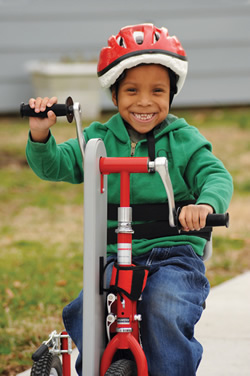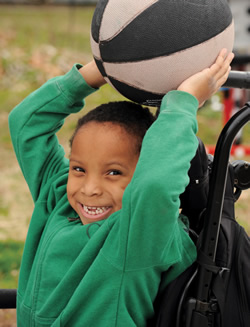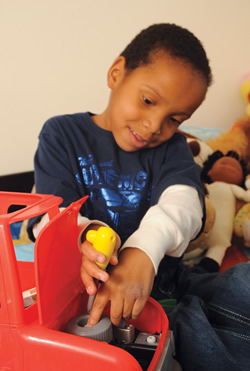CHKD’s team approach gives Hampton boy the opportunity to reach his full potential.
 Anyone who knows Jacob Garrett shouldn’t be surprised that he likes Iron Man. After all, the 5-year-old can certainly relate to the superhero who gets a boost from technology to be all he can be.
Anyone who knows Jacob Garrett shouldn’t be surprised that he likes Iron Man. After all, the 5-year-old can certainly relate to the superhero who gets a boost from technology to be all he can be.
Jacob, too, is becoming all he can be, thanks to a little technological help, his devoted family and a team of pediatric surgeons, specialists, nurses and therapists at CHKD.
Jacob was born with spina bifida, a birth defect that occurs early in pregnancy when the developing spinal column doesn’t close properly. Susan and Rick Garrett of Hampton brought him into their hearts and foster home knowing he would need lots of medical care and love. Having already adopted three children with special needs, the Garretts knew they had plenty more love to give.
“We were just learning about Jacob’s diagnosis when we brought him home from the hospital,” Susan recalls. “He’d already had surgery to close the opening at the end of his spine. We had lots of questions about what to do and what to expect. We found answers at CHKD.”
The Garretts learned that children with spina bifida usually have a combination of medical issues, including nerve damage that often causes paralysis of the legs, and bladder and bowel problems. Some also have heart problems, learning disabilities, or Chiari malformation type II, which causes a buildup of fluid in the brain.
In Jacob’s case, he has mobility challenges below his waist, plus Chiari malformation and a small hole in his heart. But his bright personality, ever-expanding vocabulary and obvious learning ability leave no doubt of his exceptional intelligence.
Susan and Rick, who quickly moved to adopt Jacob, credit CHKD’s spina bifida experts with helping them nurture his physical and mental progress. He has been followed by CHKD’s Spina Bifida Clinic since having neurosurgery as an infant to correct his Chiari malformation. During the surgery, a shunt was installed through his skull to drain excess cerebral fluid into his abdomen.
Today Jacob is one of 65 children followed by the clinic. As one of CHKD’s six multispecialty pediatric clinics, it brings CHKD surgeons together with other pediatric experts to collaborate on the care of complex disorders.
 “Clinics like these are only available at children’s hospitals,” says spina bifida clinic coordinator Elisabeth Wall-Smith. “The biggest benefit to parents is that children can see all the specialists they need in one appointment.” She adds that Jacob’s cheerful attitude and positive outlook inspire the clinic’s other children.
“Clinics like these are only available at children’s hospitals,” says spina bifida clinic coordinator Elisabeth Wall-Smith. “The biggest benefit to parents is that children can see all the specialists they need in one appointment.” She adds that Jacob’s cheerful attitude and positive outlook inspire the clinic’s other children.
“Jacob loves his clinic visits,” his mother says. “He gets to see all his doctors, therapists and nurses at one time. It takes several hours, but he is definitely in his element there, and the other children love to be around him.”
The Garretts count the clinic as a blessing. “Otherwise I would have to arrange individual appointments with ortho, neurosurgery, cardiology, urology and rehab,” Susan says, ticking off the CHKD specialists Jacob sees. The clinic is held every other month, and about 15 children are seen each time. Over the years Jacob has progressed from bi-monthly, to half-yearly to annual visits.
Orthopedic surgeon H. Sheldon St. Clair says the clinic’s case management service enables the staff to work closely with the family and ensure proper follow-up care. “This is a complex disorder that requires coordination of care,” he says, “and CHKD provides it.” Clinic staff also arrange for the necessary pre-clinic lab and radiology tests, so the physicians have the results they need on clinic day.
Jacob’s physical therapy appointments, also made through the clinic, are scheduled for the CHKD location nearest his home, which means the CHKD Health and Surgery Center at Oyster Point in Newport News. “We’re very grateful for this service,” Rick says.
Jacob uses a wheelchair and wears brace-like twister cables under his clothes from waist to shins to help him control his legs. Ankle orthotics (fitted foot forms) keep his ankles turned properly. That requires another clinic service of arranging for the orthopedic appliance representative to meet with Jacob on clinic day. “He measures and fits Jacob’s twister cables and ankle orthotics,” Susan notes, “to make sure he has the best possible support and mobility.”
Last year Jacob underwent orthopedic surgery at CHKD to lengthen the heel cords, or tendons, in both legs. “The cords become rigid and cause his feet to turn awkwardly out of position,” Dr. St. Clair explains. “In surgery, we can stretch the cords. We’ve done it twice over the years for Jacob.”
 Susan and Rick’s goal is to help their son become independent as he grows up. He already gets around home on his own, clambering onto the high platform bed he chose for himself and managing light switches with a creative assist from slender rods devised by his handyman dad. Prizing his play tools above his other toys, Jacob enjoys helping his dad fix things.
Susan and Rick’s goal is to help their son become independent as he grows up. He already gets around home on his own, clambering onto the high platform bed he chose for himself and managing light switches with a creative assist from slender rods devised by his handyman dad. Prizing his play tools above his other toys, Jacob enjoys helping his dad fix things.
“He wants to try everything,” Rick adds, “and we don’t hold him back. We let him see how far he can go.”
His three-wheel bike that works with hand pedals is kept near the front door, ready for an excursion to the neighborhood park. Jacob had swim lessons last summer – “his idea,” Susan says – and now wants to play wheelchair soccer on a team with other special-needs kids. Once a year, the family takes a camping trip to the Virginia mountains, and their youngest dearly loves Busch Gardens in the summer.
“People told us when he first came to us that there were lots of things he wouldn’t be able to do,” Susan remembers. “But our philosophy is that Jacob should decide what he can and can’t do. So far, he pretty much masters whatever he tries.”
Like Iron Man, Jacob is a force to be reckoned with.
Dr. St. Clair practices with CHKD Surgical Group’s Children’s Orthopedics and Sports Medicine.
This story was featured in the second quarter 2011 issue of KidStuff, a publication of Children's Hospital of The King's Daughters. Click to read more patients' stories.